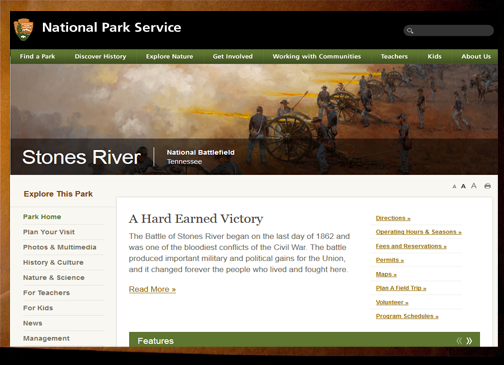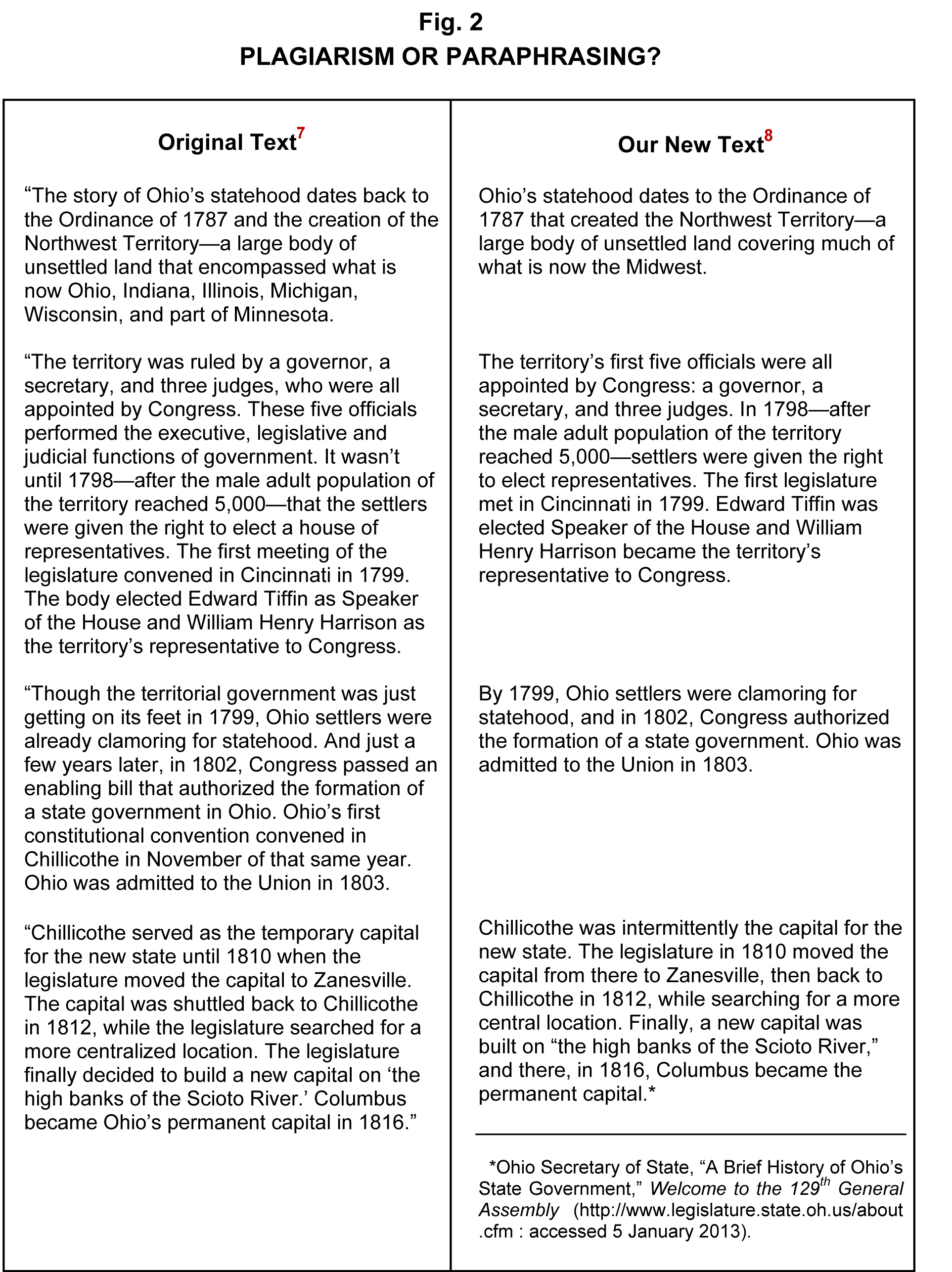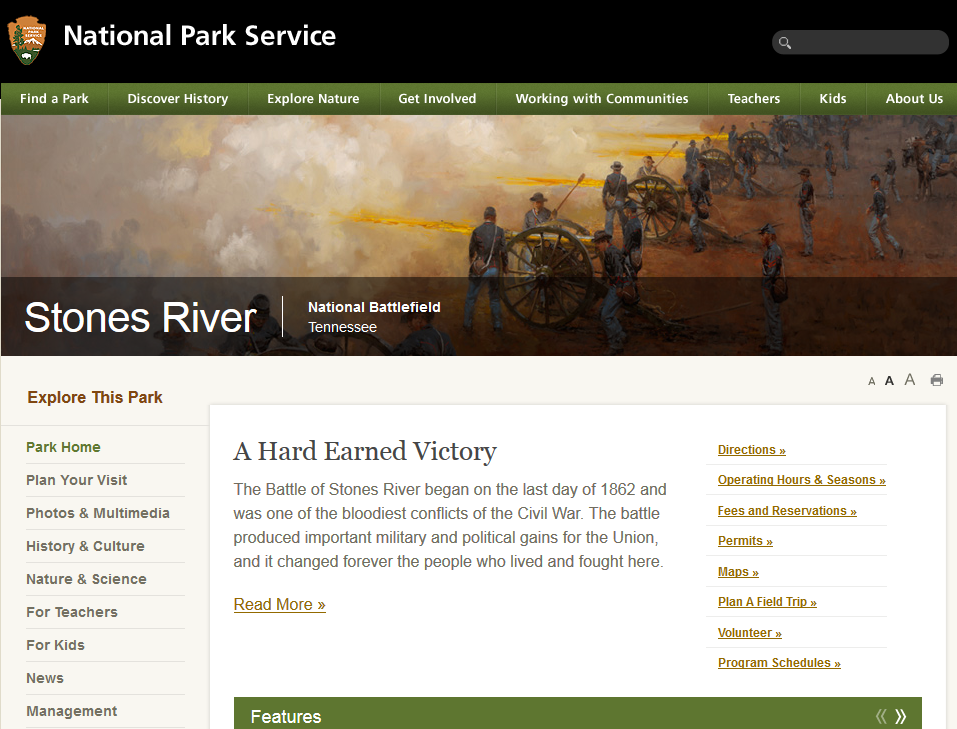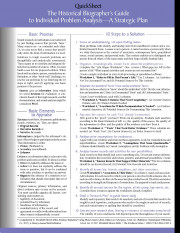
Intellectual pickpocketing. Stealing a ride on someone else’s train of thought. Taking something from someone and making it worse. Larding your lean work with the fat of others.1 Wits and sages, through the ages, have described plagiarism in many ways—not one of them flattering. The P-word is a label none of us want the world to attach to us. Yet it can happen so easily when we are inattentive, naïve, or beset by a bout of laziness.
This tutorial looks at five forms that plagiarism commonly takes among researchers and writers of history, along with safeguards we can apply to ensure we are never guilty of unfairly feeding off the creative toils of others.
Copyrights vs. "Copywrongs"
Copyright is a familiar concept in modern society. It is commonplace and commonly misunderstood. Its laws are convoluted but its basics are easy to learn. Numerous websites lay out its protections and prohibitions, explaining them in laymen’s terms.2 “Copyright Genies” help us discover whether works are still under protection, and Fair-Use Evaluators help us appraise our proposed use of protected material.3 Plagiarism detection software is almost as common as grammar checkers. Yet plagiarism happens and happens and happens.
Copywrongs are the misconceptions and misguided habits we see all around us. They are the excuses we might want to make. They are also the temptations that destroy reputations, careers, and business enterprises if we yield to them. The most-prevalent copywrongs we see among those who research and write history are these:
- Paraphrasing poorly
- Misusing public domain material
- Misunderstanding the Fair Use Doctrine
- Patchworking
- Borrowing sources
Plagiarism vs. Research
Plagiarism in any form is intellectual theft. It is the use of someone else’s work in a way that implies their ideas and words are ours. We know from every discussion of copyright that ideas cannot be copyrighted; but they can be plagiarized. We know that facts cannot be copyrighted, but the manner in which those facts are stated can be both copy-protected and plagiarized.
As researchers, we study the work of many people—or, at least, we should. We mine original sources, but we also need to study the literature of the field in order to place our new discoveries into a valid context. When we explore the work of others, we absorb many different viewpoints. We intellectually process all those differing views. We mentally wrestle with why Smith thought this but Jones thought that. We compare all these opinions and interpretations to our findings in the original records. Then, we form our own conclusions about the issues involved and present them in writing. In this process, we produce a work that is new, unique, and potentially valuable.
Plagiarism sneaks in when this process goes awry. It may happen because we doubt our own ability to synthesize the evidence correctly. We may feel that someone else has expressed a thought so well that we could not possibly improve upon it. It might happen because, in a moment of distraction amid notetaking, we forgot to put quotation marks around a passage that we copied. Or, it could happen if we have not been adequately trained in the core principles of research and writing.
This tutorial, if we apply it, should spare us the public shame of wearing the Scarlet P.
1. Paraphrasing Poorly
As researchers, we also know the importance of precision. When we synthesize the work of others, we understand the need to express their assertions as accurately as possible. The method taught to most of us in middle-school was paraphrasing.
Properly executed, paraphrasing means restating an idea in a simpler and shorter way. It does not mean changing a word or two in someone else’s sentence. It does not mean changing the sentence structure while maintaining the original words. It does not mean changing a few words to synonyms. All of this is plagiarism, not paraphrasing.
CASE AT POINT
In 1959, Samuel Eliot Morison wrote an acclaimed biography of John Paul Jones. In 1998, the Scottish biographer James Mackay presented another. Mackay was then a respected and prolific writer. The U.S. edition of his new Jones biography had just come off the press at Grove/Atlantic in 1999 when reviewers discovered countless passages in which Mackay’s narrative “shadowed” that of Morison. All copies of Mackay’s American edition were destroyed—as was his reputation.4
Figure 1 provides a simple example, juxtaposing one passage from Morison against Mackay’s counterpart:

A comparison of these two snippets clearly shows the problem. Mackay’s ideas were not his own. The words he chose were not his own, although he tinkered with them here and there. The arrangement of his thoughts was not his own. He did not paraphrase Morrison or compare Morrison’s opinions to his own. He simply copycatted his predecessor.
Mackay’s work provides a blatant, egregious, and seemingly willful example of plagiarism—one in which no credit was given to the earlier biographer who had actually labored to reconstruct the naval officer’s life and to understand both the man and his era. But: What if Mackay had footnoted his passage with a citation to Morison? Would that still be plagiarism?
CASE AT POINT
Our earlier definition of paraphrasing—the restatement of an idea in a simpler and shorter way—is not seen at all in the Mackay example. Figure 2 provides a situation that does meet that definition and also cites its source.

In this example, our new text seems to follow the classic definition of paraphrasing: It restates the original in a simpler and shorter way. It also cites its source, suggesting no intention to deceive.
Does it pass the P-Word test? No. Our new text still commits plagiarism. We have used, over and again, the exact words of the original writer without quotation marks—leaving the impression that those words are our own. We have repeated the exact sequence of ideas. The details we present might well be considered unprotected facts, but the early history of Ohio offers a vast array of facts we might choose to discuss. It is not coincidence that we have used the same few. Even though we cite a source, at the end of the four “borrowed” paragraphs, we have still committed plagiarism.
2. Misuse of Public Domain Material
Plagiarism can also infest our work when we use material in the public domain. It might be material whose copyright has expired. It might be material of the Ohio type above: publications by a government agency, whose writings carry no personal rights because they were created by public servants and financed by public funding. Again, whether our use of public domain material constitutes plagiarism depends upon how we use it.
CASE AT POINT
Amid the ongoing sesquicentennial of America’s Civil War, we might be asked to prepare—let’s say—a brochure for a historic property near the battle site at Stones River. The scope of the project does not call for original research. We’re expected only to synthesize the work of earlier historians. At the website of the National Park Service, we find a succinct statement of the battle’s significance:


The Battle of Stones River was a terrible tragedy―and these are such wrenching words. They’re also from the site of a government agency. Knowing that copyright does not apply, we paste the passage into the layout of our brochure, adding more specific text about the property adjacent to the battlefield:

Here, our quote from Sarah Stone casually identifies its source. In a tourist brochure, that informality can be acceptable. But our first paragraph commits an act of plagiarism. The fact that copyright does not apply to public-domain material does not mean that it is free for the taking, without acknowledgment.
3. Misunderstanding the Fair Use Doctrine
One aspect of the U.S. copyright law ensnares many who teach and write about history: the concept of “Fair Use.” Sections 107–18 of the current law acknowledge that even copyrighted works, or parts thereof, can be legally reproduced to meet certain legitimate needs: particularly commentary, criticism, news reporting, scholarship, or teaching.11 Fair use, however, cannot exist when plagiarism occurs.
CASE AT POINT
 At least one history instructor has found value in this research guide. The QuickSheet became the basis of a class in that instructor’s research-methodology course. The instructor’s syllabus material reproduced sections 1 and 3, reformatting it to match the instructor’s style. The “10 Steps” became ten slides in the class presentation. No quotation marks appeared around any of the reproduced material. A general note at the bottom of the syllabus page stated:
At least one history instructor has found value in this research guide. The QuickSheet became the basis of a class in that instructor’s research-methodology course. The instructor’s syllabus material reproduced sections 1 and 3, reformatting it to match the instructor’s style. The “10 Steps” became ten slides in the class presentation. No quotation marks appeared around any of the reproduced material. A general note at the bottom of the syllabus page stated:
“A useful guide for this topic has been prepared by Elizabeth Shown Mills under the title QuickSheet: The Historical Biographer’s Guide to Individual Problem Analysis—A Strategic Plan (Baltimore: 2012).”
Would you consider this approach to be Fair Use? Plagiarism? Both? Or neither?
Fair Use?
Section 107 of the Copyright Law sets forth four considerations that affect whether our reuse of copyrighted work is fair use:
- The purpose and character of the use, including whether such use is of commercial nature or is for nonprofit educational purposes
- The nature of the copyrighted work
- The amount and substantiality of the portion used in relation to the copyrighted work as a whole
- The effect of the use upon the potential market for, or value of, the copyrighted work
The purpose and character of the instructor’s use would typically meet the Fair Use principle. The material was reused for “nonprofit educational purposes.”
Judged by the third and fourth criteria, however, the reuse clearly violates the doctrine. The two-sided QuickSheet consists of four sections; the instructor reproduced two of them. Disseminating some 50 percent of a copyrighted work greatly exceeds “fair use.” In most cases, it might be expected to have an adverse effect on the “potential market” for the product.
The problem, however, goes beyond fair use. The website Plagiarism Today offers a more practical caution: “Using short, attributed snippets of a piece for the purpose of commentary or education is generally considered fair use [but] all incidents of it involve attribution. An act of plagiarism never falls under fair use.”13
Plagiarism?
Attribution, in all cases, requires a clear statement of authorship. This may be provided in some standard citation format, or it might be handled in a simple and to-the-point sentence. When material is directly quoted, attribution also means the use of quotation marks around all quoted matter.14 Attribution does not mean a generic note suggesting that readers might like to consult some outside source for additional information. In the case at hand, the instructor’s failure to use quotation marks or clear attribution left the mistaken impression that he personally wrote the material he disseminated and presented as slides. That approach is an act of plagiarism.
4. Patchworking
Patchworking is a form of plagiarism that seems to follow every letter of the law: the use of small amounts, the use of quotation marks, and the use of clear attribution. The problem might also be described using one of the tests for fair use: the “amount and substantiality” of the quoted material—in this case, its ratio in relation to the text into which it is integrated.
CASE AT POINT
Our task at hand, let us say, is a biographical sketch of a settler on the Kentucky frontier. We’ve thoroughly researched his life and the lives of contemporaries who are critical to his narrative. For historical perspective, we have consulted every firsthand account by others of his time and place—as well as every monograph in which other historians have interpreted his society.
In this process, we have taken meticulous notes. We conscientiously follow both tenets of the Rule of Three: Any time we copy three or more words from a source, we place those words in quotation marks. If we foresee using more than three paragraphs from a lengthy source, we ask permission of the author.
Eventually we reach the writing stage. Several of the quotes we’ve taken from firsthand accounts―when taken together―nicely set a stage for our subject. So, we quote them in our biography, again being meticulous in our observance of those quotation marks and reference notes.

The problem here is that we, ourselves, have written nothing, We have merely patched together the writings of others to create a block of text. Whether we copy phrases, sentences, or whole paragraphs, this approach creates no new insight. We are applying no writing skills. Stitching together patches of thoughts we have taken from others is not authorship.
Clemson University’s online guide to avoiding plagiarism explains it this way: “Use direct quotations sparingly, choosing them carefully to make an impression. A paper composed mostly of quotations from other authors runs into the plagiarism risk called ‘patchworking’.”15
5. Borrowing Sources
Borrowed sources sometimes occur as quotations, sometimes as citations. In either case, they are a more subtle form of plagiarism. Because both are commonly presented in a standard format, they may go undetected. Both are also likely to backfire against borrowers in ways most borrowers do not anticipate.
CASE AT POINT
A list-serve for historical writers recently addressed a source-citation issue, specifically: how to create a citation when we use a derivative source that cites an original record. A responder pointed out that derivative sources are considered inferior. Therefore, when a derivative source identifies an original, we should cite that original “because original records are the gold standard.”16
Yes—but no. Relying upon derivative works is risky. Copying errors, misreadings, and misinterpretations lurk in many, if not most, derivatives. As researchers, we are wise to consult the original, take our own notes, and make our own interpretation of what the original says.
Beyond this, the advice misses its mark entirely. If we do not use the original, we cannot cite what we have not used. Aside from the ethical issue involved, the practice is hazardous to our credibility as a researcher and writer. We are not only misleading others into thinking we’ve done work we have not done, we are assuming the blame for any errors our derivative source may have made.
The safe and ethical practice is the one encouraged throughout Evidence Explained, in examples such as this one from EE 11.16:17
1. “Brig Franklin: Gothenburg, Sweden to New Bedford, Massachusetts, 19 September 1831,” database, Immigrant Ships Transcribers Guild (http://www.immigrantships.net : accessed 2 February 2009), line 8, Kalvin Kneuttson, age 31; citing “National Archives and Records Administration, Film M575, Reel 5.”
This citation leads with an identification of the derivative source we actually used: the online database. Once we have fully cited that source, we may (and should) add the identification that the derivative gives for its own source. Because our source does not adequately identify the original, a safe practice is to use whatever identification we are given, placing those words inside quotation marks. Attempting to supplement a deficient citation for a source we have not used, through cataloging data found elsewhere, is itself a risky practice because the author may have consulted one edition while the cataloging data pertains to another.
The copywrong of borrowing sources is an easy one to avoid. Our guiding principle is simple: we should clarify for our own readers—and ourselves at a later date after our recollection of the source has gone cold—exactly what we used and exactly how the derivative sourced its data. Doing so ensures that we take no credit for what we did not consult and it ensures that we take no blame for any misidentification our source may have made.
Our Safeguards
When using the works of others, ten simple steps will guard us from the perils of plagiarism:
- We don’t just read the material, we study it—making certain we understand exactly what the other author intends.
- We lay aside that other work—face down.
- We write, in our own words, the key thoughts we gleaned from that source. Some of it, we will remember; some of it, we won’t. What sticks in our recollection will likely be the points most important to our own conceptual framework.
- We compare our interpretation to our source, to ensure that we have been faithful to the other writer’s intent.
- If we have inadvertently—or intentionally—copied three or more words from the original, we place those words within quotation marks.
- We conduct other research, in other relevant works, handling each in the same way.
Eventually, when we reach the point of writing our own narrative, we apply our last four steps.
- We review the notes we’ve taken from all sources.
- We compare and correlate all the various views.
- We form our own conclusions about the issues involved.
- We write a passage—or a narrative—that (a) reflects our own interpretation of the subject at hand and, if appropriate, (b) discusses the extent to which our conclusions differ from those of other writers whose views we take pains to fairly represent.
Bottom Line
Plagiarism—a word that centers upon personal ethics—is a word most charitable people hate to utter. Much of the public assumes, in fact, that its principles are covered by copyright. They are not. The difference between the two concepts is expressed by the old saw What’s legal is not always ethical and what’s ethical is not always covered by any law. As researchers and writers, when the devil on our shoulder tempts us to take shortcuts with our notetaking and our writing, the better voice to heed would be that of Marguerite Gardiner, Countess of Blessington who is said to have quipped: “Borrowed words, like borrowed money, speak to the poverty of the borrower.”18
1. Quotation marks are not used for the widely quoted quips in this introductory paragraph, because the quips vary slightly between different quotation compendiums. As a starting point for each, see the following:
- Stealing a ride: Mark McCutcheon, Roget’s Super Thesaurus (Cincinnati, Ohio: Writers Digest Books, 2010), 442, attributed to Russel Curran.
- Taking something: Roy B. Zuch, The Speaker’s Quote Book: Over 5,000 Illustrations and Quotations for All Occasions (Grand Rapids, Mich.: Kregel Academic, 2009), 384, attributed to George Moore.
- Larding your lean works: “Plagiarism Quotes, Quotations, and Sayings,” World of Quotes.com (www.worldofquotes.com/topic/plagiarism/1/ : 5 January 2013), citing Robert Burton, Anatomy of Melancholy.
2. Three excellent sites for understanding copyright are
- U.S. Library of Congress, Copyright Law of the United States (http://www.copyright.gov/title17/).
- "Copyright and Fair Use in the UMUC Online or Face-to-Face Classroom," University of Maryland—University College (http://www.umuc.edu/library/libhow/copyright.cfm), a sound and easily digested approach.
- Stanford University Libraries, Copyright and Fair Use (http://fairuse.stanford.edu/), a comprehensive treatment offering answers to almost any kind of issue you are facing.
3. Michael Brewer, "Is It Covered by Copyright?" American Library Association Office for Information Technology Policy, Copyright Advisory Network (http://librarycopyright.net/resources/genie/index.php?restart : created 2012).
4. For more on this and similar sins by Mackay, see Ralph Blumenthal with Sarah Lyall, “Repeat Accusations of Plagiarism Taint Prolific Biographer,” New York Times, 21 September 1999 (archived at http://www.nytimes.com/1999/09/21/books/repeat-accusations-of-plagiarism-taint-prolific-biographer.html); Ralph Blumenthal, “Publisher Cancels Biography after Plagiarism Inquiry,” New York Times, 25 September 1999 (archived at http://www.nytimes.com/1999/09/25/books/publisher-cancels-biography-after-plagiarism-inquiry.html); Harold J. Noah and Max A. Eckstein, Fraud and Education: The Worm in the Apple (Oxford: Rowman and Littlefield, 2001), 109; and “James Mackay,” Soylent Communications, NNBD: Tracking the Entire World (http://www.nndb.com/people/473/000045338/ : accessed 5 January 2013).
5. Samuel Eliot Morison, John Paul Jones: A Sailor’s Biography (Boston: Little Brown, 1949), 37.
6. James Mackay, I Have Not Yet Begun to Fight: A Life of John Paul Jones (Edinburgh: Mainstream Publishing, 1998), 33; the quote is taken here from the Scottish edition because no known copies survive for the American edition discussed in the text.
7. Ohio Secretary of State, “A Brief History of Ohio’s State Government,” Welcome to the 129th General Assembly (https://www.legislature.ohio.gov/publications/a-brief-history : accessed 5 January 2013, updated 28 October 2018).
8. New text by the present writer, designed only as an instructive example.
9. National Park Service, Stones River | National Battlefield, Tennessee (http://www.nps.gov/stri/index.htm : accessed 5 January 2013).
10. “Stonington House” does not actually exist. A fictitious entity is used here to set up the example.
11. U.S. Library of Congress, “Fair Use,” Copyright Law of the United States (http://www.copyright.gov/fls/fl102.html : updated December 2011).
12. Elizabeth Shown Mills, QuickSheet: The Historical Biographer’s Guide to Individual Problem Analysis—A Strategic Plan (Baltimore: Genealogical Publishing Co., 2012).
13. Jonathan Bailey, “Copyright Infringement, Plagiarism, and Fair Use,” Plagiarism Today (http://www.plagiarismtoday.com/2005/10/06/copyright-infringement-plagiarism-and-fair-use/ : accessed 5 January 2013).
14. When quoting long passages, a longstanding American convention allows us to set off the material in an indented format, accompanied by a specific citation of source. Indented quotes, by this convention, do not have to carry quotation marks. However, using quotation marks can be the wiser choice, given that many modern readers are not familiar with writing conventions.
15. “Avoiding Plagiarism,” Clemson University, Clemson Libraries (http://www.clemson.edu/culib/Plagiarism/DirectQuotations.htm : accessed 5 January 2013). This paper has been dropped from the current website; the same points are made in a site-sponsored slide presentation by the university librarian Bobby Hollandsworth, "Plagiarism: What You Need to Know," Clemson Libraries (https://cpb-us-w2.wpmucdn.com/blogs.cofc.edu/dist/c/13/files/2010/02/Plagiarism_BHollandsworth_CofCFacts.pdf : last checked 28 October 20108).
16. The source will not be cited here to avoid publicly calling out a naïve but seemingly well-intentioned newcomer to the pursuit of history.
17. Elizabeth Shown Mills, Evidence Explained: Citing History Sources from Artifacts to Cyberspace, 2d rev. ed. (Baltimore: Genealogical Publishing Co., 2012), 577; electronic edition available at https://www.evidenceexplained.com/magento/index.php/evidence-explained-13.html.
18. Quotes in Can (http://quotesincan.com/category/quotes/plagiarism-quotes/ : 5 January 2013). And yes, EE recognizes the irony of borrowing Gardiner’s words to make this point about borrowed words. In doing so, EE is making another point: quoting others is acceptable so long as we (a) give credit; and (b) follow Clemson’s advice to “Use direct quotations sparingly, choosing them carefully to make an impression.” Excluding the graphics used for comparative analysis, the three quotations used in the remaining 3600-or-so words of this QuickLesson contains a total of just 73 words. That is a healthy and effective ratio.
How to Cite This Lesson
Elizabeth Shown Mills, “QuickLesson 15: Plagiarism―Five "Copywrongs" of Historical Writing,” Evidence Explained: Historical Analysis, Citation & Source Usage (https://www.evidenceexplained.com/content/quicklesson-15-plagiarism—five-copywrongs-historical-writing : [access date]).